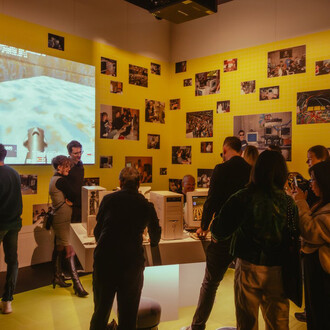Margaret Ackland’s large scale still life watercolours, featuring glassware, flowers, and tablecloths, have been imbued with a deeper, subtle meaning. Continuing in the vein of her past work, which explored the intersect of politics and domesticity, Ackland brings the political climate of both the present and the past to the table and encourages viewers to seek out the visual anomalies within her images that speak to the complexities of human experience.
An orchid sent to Margaret Ackland by a dear friend miraculously red blossomed and has kept up a constant cycle of flowering ever since. The meandering stems and roots of this and other plant life remind us of the fragility and unexpected turns of life. Like a drawn line, the understated beauty of their natural forms inspire us to look for reflections, distortions and the unexpected in the world around us.
During my conversation with Margaret Ackland, it strikes me that she uses the words ‘mundane’ and ‘profound’ more than once when talking about moments of her life and creative practice. These two words are at the heart of still life painting itself, a genre which Ackland explores in the form of sumptuous large-scale watercolours in her exhibition Lifelines.
On one hand, the tradition of still life could simply be viewed as an arrangement of objects, often within a mundane domestic setting using inanimate household items. On the other hand, centuries of still life painting demonstrates that there is great profundity to be discovered. Allegorical and vanitas still life paintings contain richly symbolic imagery, prompting contemplation on the relative brevity of our lives. In the same way our own death is inevitable, a flower blooms but inevitably withers and browns over time. Ackland’s work The last magnolias is both a celebration of the last flower of the season and a mourning for the end of the bloom.
Reflections of light are a regular feature of Ackland’s watercolours, and if you peer closely enough you may catch the occasional glimpse of the artist herself in mirrored surfaces. Artists have been hiding likenesses of themselves in their paintings since the fifteenth century, the most notable example being Northern Renaissance painter Jan van Eyck in The Arnolfini portrait, 1434. Although scholars continue to debate the inclusion of van Eyck’s self-portrait hiding in the enigmatic wedding portrait, there is no doubt that the curved surfaces of the silver teapot and water jug in Scenes from a marriage contain the likeness of Ackland and her husband Vic. Instead of a stiff portrait of newlyweds posing uncomfortably in their finery, Ackland’s domestic scene, snapped with her iPhone, depicts the ease and comfort of a long marriage.
Ackland also looks to the world beyond her domestic setting. Children playing across the surface of pink wallpaper in her work Fragile are drawn from footage of children in contemporary war zones, highlighting their vulnerability in the face of conflict. Guns and roses features a bowl of roses against the backdrop of an Afghan war rug, a form of weaving which developed in response to ongoing conflict in Afghanistan in the second half of the twentieth century. It’s difficult to gaze upon the tanks and fighter jets depicted on the rug without thinking of recent conflicts in Gaza and the Ukraine.
In the same way that van Eyck coded his wedding portrait with iconography, Ackland hides symbols in her watercolours. The rugs and textiles used as backdrops contain the initials of family members and deeply personal symbols. These serve as embedded mementos to honour departed loved ones and are intended to remain ambiguous to the viewer.
The title work of the exhibition, Lifelines, shows the tendrils of an orchid reaching towards the light. The orchid was a gift from a friend of Ackland which continues to thrive and bloom. Like the branches of a family tree, the outstretched limbs represent the profound nature of human connection and the pure white petals of the orchid – which will soon shrivel and discolour – serve as a poignant reminder of our brief time on this mortal coil.
(Essay by Julie McLaren, curator, art gallery of Ballarat)
Margaret Ackland has been a finalist the Hazelhurst Art on Paper Award (2023) the Portia Geach Portrait Prize (2022, 2021, 2004), was the winner of the Portia Geach People's Choice Award (2021), was semi-finalist in the Doug Moran National Portrait Prize (2022), and finalist in the Salon des Refusés (2020), the Hazelhurst Art on Paper Award (2023, 2021, 2019), the Gallipoli Prize (2014), and the Blake Prize (2012, 2008, 2007). Her work has been featured in Italian Vogue and on ABC TV's Compass Series. In 2012 she was included in Not the way home: 13 artists paint the desert, a group expedition organised by Artist profile magazine and exhibited at the National Trust S.H. Ervin Gallery, Sydney. In 2016 Ackland held a major regional solo exhibition of The watercolour news at the Gippsland Art Gallery in Sale. In 2018 Ackland was commissioned to create a major work for the new Inter Continental Hotel in Bangladesh, the country's first major international hotel. Ackland's work is represented in a range of national collections including Artbank, the Holmes a Court Collection, the Bennett Art Collection (USA) and Deakin University.
















